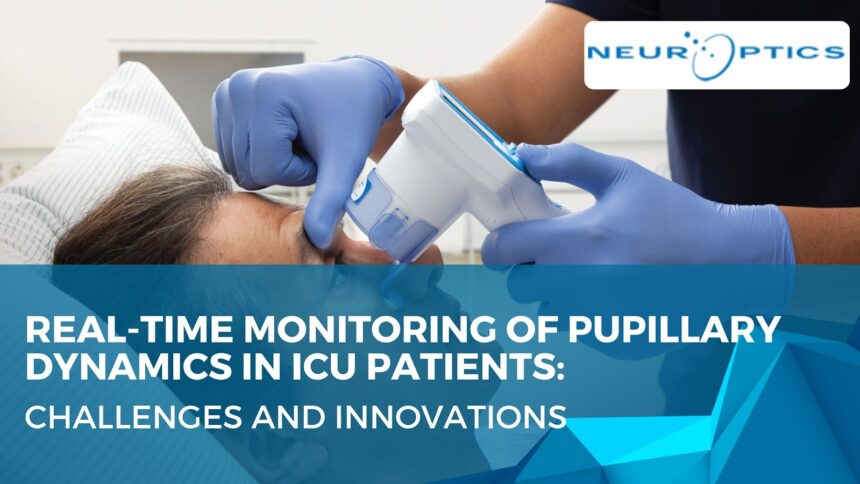Introduction
Pupillary dynamics are valuable sources of information about neurological function, especially in ICU patients. Real-time monitoring of pupillary size measurement and reactivity can potentially enable clinicians to detect subtle early warning signs of deterioration, like Pupillary Response in Traumatic Brain Injury. But the use of real-time pupillary monitoring in intensive care is not without challenges, from the technology to the clinical uptake, including the need for standardized protocols and training of healthcare workers. This blog addresses such challenges and how recent developments improve ICU pupillary exams.
The Importance of Pupillary Evaluation in ICU Patients
Pupillary light reflex (PLR) is an important diagnostic tool in neurological assessment. Abnormalities in measurement of pupillary size and reactivity in critically ill patients can indicate:
- Traumatic Brain Injury (TBI): Pupil changes can indicate the severity of injury. Pupillary response changes can also be used to monitor the course of TBI over time.
- Increased Intracranial Pressure (ICP): Dilated, non-reactive pupil is a bad prognostic sign. Pupillary change monitoring is important for the early detection of elevated ICP and the requirement for intervention.
- Stroke or Hemorrhage: Pupillary abnormalities can localize the site of brain involvement. Pupillary change monitoring is important for the early detection of elevated ICP and the requirement for intervention.
- Metabolic or Toxic Encephalopathies: These conditions can impact brain function diffusely, usually causing changes in pupillary size and reactivity, such as pinpoint pupils or delayed responses. Pupillary reactivity and size changes may be caused by these diseases.
By live monitoring, physicians are able to track millisecond variations in pupillary responses, resulting in more rapid intervention and improved patient care.
Challenges in Real-Time Pupillary Monitoring
Variability in Manual Evaluation
Older pupillary tests, relying on subjective penlight examination, are plagued by variability. Ambient illumination, examiner technique variability, and unavoidable human error compromise reliability, particularly in the difficult ICU environment where small changes are critical. Such subjectivity can delay detection of critical neurological changes.
Technological Limitations
Though accuracy is enhanced by automated pupillometers, their introduction into ICU protocols is not free of difficulties. Hospital budgetary limitations could stop them from being used. ICU staff would need training on new technology to use it to the fullest. Integration with existing monitoring systems could be another integration problem.
Interpreting and Understanding Pupil Measurements
More advanced devices provide measures such as the Neurological Pupil Index (NPI), requiring specialized clinical expertise in correct interpretation. Standardized response thresholds across broad ranges of patient conditions and critical care environments remain a significant barrier to maximizing clinical utility of pupillary monitoring. Guidelines for interpreting such measurements are needed.
Innovations Transforming Pupillary Monitoring
Automated Pupillometry for Standardized Assessments
Electronic pupillometers are a major breakthrough by eliminating the subjectivity of manual pupil evaluation. The machines offer reproducible and objective pupillary measurements, quantifying such important parameters as pupillary light reflex (PLR), latency, and constriction velocity. Real-time information collected through automated pupillometry provides doctors with more precise data to make informed decisions.
AI-Powered Data Analysis
Machine algorithms are transforming pupillary response evaluations, especially in Traumatic Brain Injury. The machine algorithms can identify subtle trends and patterns in pupillary data that may not be detected in manual exams. AI-driven analytics aid clinicians in predicting patient deterioration and individualizing treatment protocols.
Interoperability with ICU Monitoring Platforms
Incorporating real-time pupillometry into current ICU monitoring platforms allows better comprehension of the patient’s status. Clinicians can cross-reference pupillary changes with other vital signs, neurological imaging, and other relevant information. This facilitates earlier identification of neurological deterioration and more effective, timely interventions.
Clinical Implications and Future Directions
Enhancing Patient Outcomes
Automated pupillary testing gives clinicians the advantage of quicker, evidence-based decisions, essential in the hectic ICU setting. This quicker response avoids secondary brain injury and ultimately leads to greater survival rates for critical care patients. Objective evidence from pupillometry enables more accurate and timely interventions.
Greater Use in Critical Care Units
With advances in neurologic equipment, greater availability, and lower costs, their use in broader sections of ICUs can be expected. Greater availability of these devices will make standardized pupillary measurements routine practice. Development and implementation of standardized guidelines for pupillary size measurement and interpretation will also enhance diagnostic accuracy and treatment success, resulting in uniform, high-quality care.
The Future of Neurocritical Care
New technologies are the solution to transforming neurocritical care. Wearable pupil-monitoring devices hold out the promise of continuous, unobtrusive monitoring. AI-based predictive analytics hold out the promise of enhancing neurological assessment by detecting subtle trends that signal deterioration. These technologies facilitate more proactive and personalized critical care management, resulting in best patient outcomes.
Conclusion
Real-time ICU pupillary monitoring is transforming critical care with real-time precise information on neurological well-being. The challenges aside, technological advancements in the field such as autonomous pupillometry and AI-driven analytics are filling the gap. As increasing numbers of clinics adopt these neurological tools, they will be a standard driving force for patient care and neuro monitoring within the ICU.
Learn more about Neuroptics, the pioneering pupillary assessment solutions, and how real-time monitoring is revolutionizing neurocritical care.







